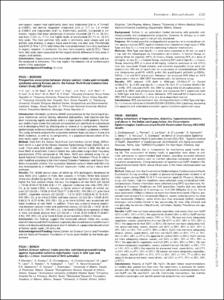KUMEL Repository
1. Journal Papers (연구논문)
1. School of Medicine (의과대학)
Dept. of Preventive Medicine (예방의학)
Prospective association between dietary calcium intake and metabolic syndrome among Korean adults: the Korean Multi-Rural Communities Cohort Study (MR Cohort)
- Keimyung Author(s)
- Shin, Dong Hoon
- Department
- Dept. of Preventive Medicine (예방의학)
- Journal Title
- European Heart Journal
- Issued Date
- 2017
- Volume
- 38
- Issue
- suppl.1
- Keyword
- metabolic syndrome x; adult; dietary calcium; community
- Abstract
- Introduction: Metabolic syndrome (MetS) characterized by the clustering of glucose intolerance, central obesity, abnormal lipid profiles, and hypertension has been increasing rapidly worldwide and is a major public health problem. Numerous studies have shown that calcium consumption can contribute to a decreased risk of developing MetS by affecting one or several of its components. However, epidemiologic evidence relating calcium intake and metabolic syndrome is limited. This study aimed to evaluate the association between habitual calcium intake and MetS incidence, as well as its components, in a population-based cohort of Korean adults aged ≥40 years old.
Method: Data from the Korean Multi-Rural Communities Cohort Study (MRCohort) which is a part of the Korean Genome Epidemiology Study (KoGES), were used. There were total 5,509 subjects (men 2,204, women 3,305) who did not have MetS at enrollment. Calcium intake was calculated using a food frequency questionnaire (FFQ) composed of 106 items. MetS was defined using the updated National Cholesterol Education Program Adult Treatment Panel III criteria after modified according to the International Diabetes Federation and Korean Diabetes Association criteria. The association between calcium intake and Mets risk was investigated by a modified Poisson regression model, using a robust error estimator.
Results: For 18,880 person-years of follow-up, 876 participants developed de novo MetS (312 subjects in male, 564 subjects in female). When total calcium intake was divided by quintile, it was not statistically significant for males, but the higher the total calcium intake, the less the diagnosis of new MetS (Q1:Q3:Q5 = 1:0.56 (0.40–0.78):0.85 (0.61–1.17, adjusted incidence rate ratio (IRR) (95% CI), p for trend 0.922), In females, a higher amount of intake of animal calcium (Q1:Q3:Q5 = 1:0.58 (0.45–0.75):0.71 (0.55–0.92), IRR (95% CI), p for trend 0.0091), vegetable calcium (Q1:Q3:Q5 = 1:0.73 (0.57–0.93):0.48 (0.73–0.81), IRR (95% CI), p for trend 0.0304) and total calcium (Q1:Q3:Q5 = 1:0.69 (0.54–0.88):0.74 (0.57–0.96), IRR (95% CI), p for trend 0.0434) was associated with lower incidence of new MetS. In addition, There was a mainly inverse relationship between calcium intake and abdominal obesity (Q1:Q3:Q5 = 1:0.57 (0.40–0.81):0.50 (0.35–0.72), IRR (95% CI), p for trend 0.0006) of components of Mets in male and blood glucose level (Q1:Q3:Q5 = 1:0.68 (0.55–0.85):0.75 (0.607–0.93), IRR (95% CI), p for trend 0.0336) of components of Mets in female.
Conclusion: Our findings suggest that increased calcium intake was associated with decreased MetS incidence, especially decreased waist circumference in males and decreased blood glucose level in females in a population-based cohort of Korean adults aged ≥40 years old.
Acknowledgement/Funding: Korea Centers for Disease Control and Prevention and the National Research Foundation of Korea grant funded by the Korea government
- Keimyung Author(s)(Kor)
- 신동훈
- Publisher
- School of Medicine (의과대학)
- Citation
- Y.-H. Lim et al. (2017). Prospective association between dietary calcium intake and metabolic syndrome among Korean adults: the Korean Multi-Rural Communities Cohort Study (MR Cohort). European Heart Journal, 38(suppl.1), 1121–1121. doi: 10.1093/eurheartj/ehx493.P5323
- Type
- Article
- ISSN
- 0195-668X
- Appears in Collections:
- 1. School of Medicine (의과대학) > Dept. of Preventive Medicine (예방의학)
- 파일 목록
-
-
Download
 oak-2018-0910.pdf
기타 데이터 / 98.22 kB / Adobe PDF
oak-2018-0910.pdf
기타 데이터 / 98.22 kB / Adobe PDF
-
Items in Repository are protected by copyright, with all rights reserved, unless otherwise indicated.